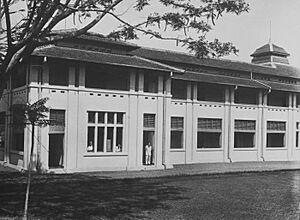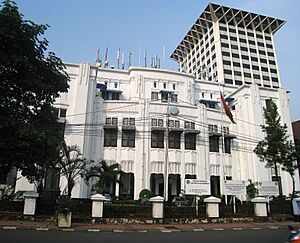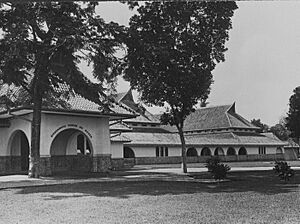Frans Johan Louwrens Ghijsels facts for kids
Frans Johan Louwrens Ghijsels (born September 8, 1882, in Tulungagung – died March 2, 1947, in Overveen, Bloemendaal) was a talented Dutch architect and city planner. He worked in both the Netherlands and the Dutch East Indies, which is now Indonesia. Ghijsels was the person who started AIA, which became the largest architecture firm in the Dutch East Indies. He played a big part in creating a modern building style that was special to the Dutch East Indies.
Contents
Frans Ghijsels' Life Story
In 1903, Frans Ghijsels began studying at the polytechnic university in Delft. Many of his classmates also became famous architects in the East Indies, like Thomas Karsten and Henri Maclaine Pont.
After finishing his studies in 1909, Ghijsels first worked as a government supervisor for buildings in Amsterdam. In the same year, he got married in Rotterdam.
By late 1910, Ghijsels moved to the Dutch East Indies. He got a job as an engineer for the city of Batavia (now Jakarta). From 1913, he worked for the Department of Civil Works. He also started working as a freelance architect.
Between 1913 and 1915, he designed a large three-story building in Surabaya. This was for the Post, Telephone, and Telegraph office (PTT), and it's now called Gedung Telkom. This building was one of the first modern buildings in Surabaya. He also designed a PTT office for an exhibition in Semarang in 1914.
In 1914, Ghijsels designed the Petamboeran hospital in Batavia. This hospital was for the Royal Packet Company (KPM). It is now known as Pelni Petamburan Hospital. KPM was so happy with his work that they asked him to design their main office building. This led Ghijsels to create his own private architecture company.
He formed AIA (Algemeen Ingenieurs- en Architectenbureau), which means "General Engineering and Architecture Bureau." He started it with architect H. von Essen and builder F. Stoltz. AIA became one of the largest architecture and building companies in the Dutch East Indies. In 1927, AIA opened another office in Surabaya. By 1932, AIA teamed up with another firm in Bandung.
Ghijsels was a very important part of AIA until 1929. He then moved back to the Netherlands. Even from far away, he continued to work on many AIA projects in the Dutch East Indies. In the 1930s, Ghijsels designed sketches for his own house. He also designed a clubhouse for the Bloemendaal Hockeyclub in the Netherlands. Ghijsels passed away on March 2, 1947.
AIA: Ghijsels' Architecture Company
The very first project for AIA was the KPM headquarters in Batavia. This building was a huge success and was praised by many people. After this project, AIA received many requests to design other commercial buildings.
Some of AIA's other famous works include the Kota railway station and the Hotel des Indes in Batavia. The Hotel des Indes was taken down in 1972. In Surabaya, Ghijsels designed the Internatio Building. He also designed the "Onder de Bogen" hospital in Yogyakarta. This hospital is a great example of a building with more of an Indies Style.
In Bandung, the famous Villa Isola was designed by Wolff Schoemaker. Schoemaker was also connected to AIA. AIA also received big projects for water management systems. This happened after they joined with another company in 1936.
Other architects who worked with AIA included HA Hes, FBH Asselberg, and NE Burhoven Jaspers. Stoltz left the company in 1921, and Hein von Essen had already left earlier. After 1945, Indonesian engineers Tan and Soetono led the office. Today, the company still exists in Surabaya, using its old name: PT Biro AIA.
Ghijsels' Building Style
In the early 1900s, there were two main groups of modern architects in the Dutch East Indies. One group followed the Western building styles they learned in school. The other group tried to mix Western styles with traditional Indies styles.
Ghijsels belonged to the first group, focusing more on Western styles. However, he was known for using different styles for different types of buildings. For offices and commercial buildings, he used a more "formal" Western style. But for schools and hospitals, he chose a more "informal" Indies Style.
Some of Ghijsels' works that show more of the Indies Style include the "Onder de Bogen" hospital (now Panti Rapih Hospital). The KPM hospital (now Pelni Petamburan Hospital) also shows this style. This idea of using different styles for different buildings helped start discussions about the importance of the colonial Indies Style.
A newspaper in the Dutch East Indies, De Indische Courant, wrote about Ghijsels' work in 1925. It quoted, "Simplicity is the shortest path to beauty." This quote perfectly describes Ghijsels' clean and Modernist building style.
Buildings Designed by Ghijsels
Here is a list of some buildings Ghijsels designed in Jakarta:
- KPM Hospital Petamboeran (1914–15) - now RS PELNI
- KPM Head Office (1917–18) - now Kantor Departemen Perhubungan Laut
- Office of John Peet & Co. (1920) - now PT Toshiba
- Office of Maintz & Co. (1920) - now PT Samudera Indonesia
- Roman Catholic Church H. Jozef (1923) - St. Joseph's Church
- Office of Geo Wehry & Co (1926)
- Lodge for Freemasons (1925) - now BAPPENAS
- Training College ”Vereeniging Associatie van Oost & West (1918)
- Boarding School: Jan Pieterz. Coentichting (1923–27)
- School Complex for the Association of Christian Schools (1927) - now SMA Jl. Diponegoro
- Station BEOS (1929)
- Hotel des Indes (1930) - no longer standing
- Club House for Roemer Visscher Society (1928)
- Tjikini Swimming Pool (1925)
- Parts of Municipal Urban Development in Menteng (1920)
- Nassau church (1936) - now St. Paul's Church, Jakarta
See also
- Colonial architecture of Indonesia
- List of colonial buildings and structures in Jakarta
- New Indies Style







